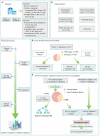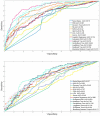Prognostic analysis of high-flow nasal cannula therapy and non-invasive ventilation in mild to moderate hypoxemia patients and construction of a machine learning model for 48-h intubation prediction-a retrospective analysis of the MIMIC database
- PMID: 38495114
- PMCID: PMC10941954
- DOI: 10.3389/fmed.2024.1213169
Prognostic analysis of high-flow nasal cannula therapy and non-invasive ventilation in mild to moderate hypoxemia patients and construction of a machine learning model for 48-h intubation prediction-a retrospective analysis of the MIMIC database
Abstract
Background: This study aims to investigate the clinical outcome between high-flow nasal cannula (HFNC) and non-invasive ventilation (NIV) therapy in mild to moderate hypoxemic patients on the first ICU day and to develop a predictive model of 48-h intubation.
Methods: The study included adult patients from the MIMIC III and IV databases who first initiated HFNC or NIV therapy due to mild to moderate hypoxemia (100 < PaO2/FiO2 ≤ 300). The 48-h and 30-day intubation rates were compared using cross-sectional and survival analysis. Nine machine learning and six ensemble algorithms were deployed to construct the 48-h intubation predictive models, of which the optimal model was determined by its prediction accuracy. The top 10 risk and protective factors were identified using the Shapley interpretation algorithm.
Result: A total of 123,042 patients were screened, of which, 673 were from the MIMIC IV database for ventilation therapy comparison (HFNC n = 363, NIV n = 310) and 48-h intubation predictive model construction (training dataset n = 471, internal validation set n = 202) and 408 were from the MIMIC III database for external validation. The NIV group had a lower intubation rate (23.1% vs. 16.1%, p = 0.001), ICU 28-day mortality (18.5% vs. 11.6%, p = 0.014), and in-hospital mortality (19.6% vs. 11.9%, p = 0.007) compared to the HFNC group. Survival analysis showed that the total and 48-h intubation rates were not significantly different. The ensemble AdaBoost decision tree model (internal and external validation set AUROC 0.878, 0.726) had the best predictive accuracy performance. The model Shapley algorithm showed Sequential Organ Failure Assessment (SOFA), acute physiology scores (APSIII), the minimum and maximum lactate value as risk factors for early failure and age, the maximum PaCO2 and PH value, Glasgow Coma Scale (GCS), the minimum PaO2/FiO2 ratio, and PaO2 value as protective factors.
Conclusion: NIV was associated with lower intubation rate and ICU 28-day and in-hospital mortality. Further survival analysis reinforced that the effect of NIV on the intubation rate might partly be attributed to the other impact factors. The ensemble AdaBoost decision tree model may assist clinicians in making clinical decisions, and early organ function support to improve patients' SOFA, APSIII, GCS, PaCO2, PaO2, PH, PaO2/FiO2 ratio, and lactate values can reduce the early failure rate and improve patient prognosis.
Keywords: 48-h intubation risk predictive model; ICU 28-day mortality; high flow nasal cannula; maching learning; non-invasive ventilation.
Copyright © 2024 Fu, Liu, Guan, Lin, He, Niu, Huang, Liu and Chen.
Conflict of interest statement
The authors declare that the research was conducted in the absence of any commercial or financial relationships that could be construed as a potential conflict of interest.
Figures





Similar articles
-
[Effect of high-flow nasal cannula oxygen on patients with chronic obstructive pulmonary disease and mild hypercapnia: a retrospective cohort study based on the Medical Information Mart for Intensive Care-IV database].Zhonghua Wei Zhong Bing Ji Jiu Yi Xue. 2021 Jun;33(6):686-691. doi: 10.3760/cma.j.cn121430-20210219-00258. Zhonghua Wei Zhong Bing Ji Jiu Yi Xue. 2021. PMID: 34296687 Chinese.
-
Efficacy of High-Flow Nasal Cannula Oxygen Therapy in Patients with Mild Hypercapnia.Lung. 2021 Oct;199(5):447-456. doi: 10.1007/s00408-021-00472-4. Epub 2021 Aug 27. Lung. 2021. PMID: 34448939 Free PMC article.
-
Limitations of the ARDS criteria during high-flow oxygen or non-invasive ventilation: evidence from critically ill COVID-19 patients.Crit Care. 2022 Mar 7;26(1):55. doi: 10.1186/s13054-022-03933-1. Crit Care. 2022. PMID: 35255949 Free PMC article.
-
Comparison between high-flow nasal cannula and noninvasive ventilation in COVID-19 patients: a systematic review and meta-analysis.Ther Adv Respir Dis. 2022 Jan-Dec;16:17534666221113663. doi: 10.1177/17534666221113663. Ther Adv Respir Dis. 2022. PMID: 35861299 Free PMC article.
-
High flow nasal cannula oxygen versus noninvasive ventilation in adult acute respiratory failure: a systematic review of randomized-controlled trials.Eur J Emerg Med. 2019 Feb;26(1):9-18. doi: 10.1097/MEJ.0000000000000557. Eur J Emerg Med. 2019. PMID: 29923842
Cited by
-
Association Between the Glucose-to-Lymphocyte Ratio and 28-Day Mortality in Patients with Mechanical Ventilation.Balkan Med J. 2025 Jul 1;42(4):358-366. doi: 10.4274/balkanmedj.galenos.2025.2025-2-49. Balkan Med J. 2025. PMID: 40619841 Free PMC article.
References
-
- Roupie E, Lepage E, Wysocki M, Fagon JY, Chastre J, Dreyfuss D, et al. . Prevalence, etiologies and outcome of the acute respiratory distress syndrome among hypoxemic ventilated patients. SRLF Collaborative Group on Mechanical Ventilation. Société de Réanimation de Langue Française. Intensive Care Med. (1999) 25:920–9. doi: 10.1007/s001340050983 - DOI - PubMed
LinkOut - more resources
Full Text Sources

